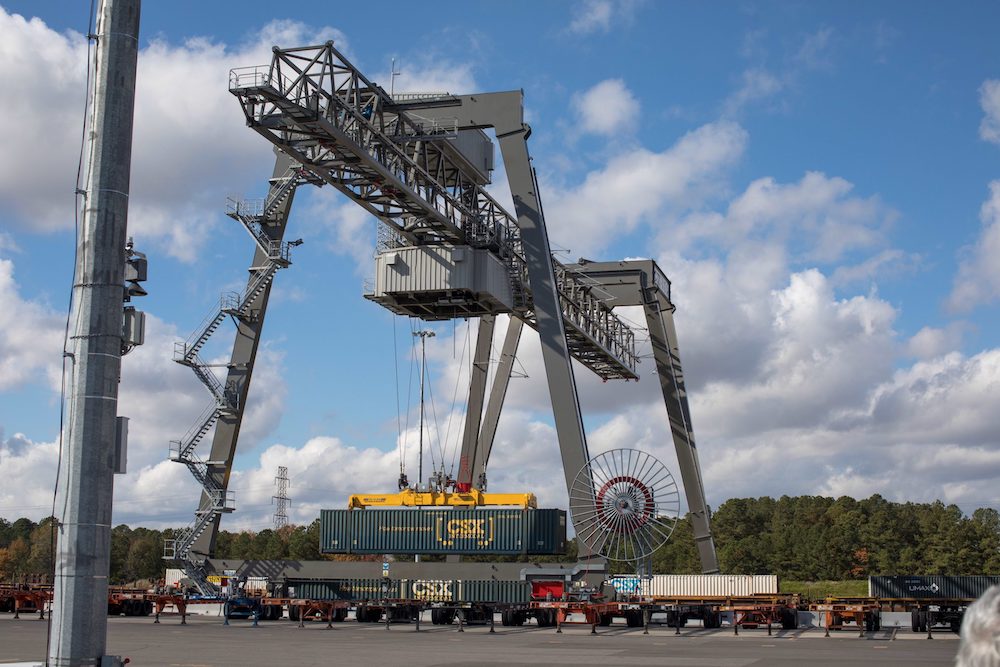
SAVANNAH, Ga. – CSX Transportation and the Georgia Ports Authority have teamed up for daily international intermodal service between the Port of Savannah and Rocky Mount, N.C.
The railroad and port authority said that the service would enable North Carolina importers and exporters to tap into a faster supply chain through the direct rail connection between the port and CSX’s Carolina Connector intermodal terminal.
“This is an exciting logistics solution for existing and new customers across North Carolina,” Georgia Ports Authority CEO Griff Lynch said in a statement today. “In collaboration with CSX, we’re offering daily access and faster service, bringing world-class port services to the doorstep of the area’s business and industry.”
The container traffic will move in existing trains that handle both intermodal and manifest business, CSX says. The rail move is 382 miles from the port authority’s Mason Mega Rail Terminal in Savannah and the CCX terminal at Rocky Mount.
The transit time from ship to shore to Rocky Mount will be three days.
“CSX is proud to be a part of this transformative partnership, which embodies our commitment to foster growth, connect markets and propel economic progress for the region,” Kevin Boone, the railroad’s executive vice president of sales and marketing, said in a statement. “The integration of GPA’s On-Dock Rail and the Inland Port at CCX signifies a leap forward in providing efficient, sustainable, and dynamic rail-to-truck inland port container service for our customers.”
Savannah has been among the fastest-growing ports in the U.S. and has benefitted from the shift of imports to the East Coast from West Coast ports.
“Customers can get access to cargo more quickly on the Carolina Connector service, because Savannah is a first port of call for ocean carriers transiting the Panama Canal,” Lynch said. “Containers are ready for pick-up at CCX before they can even be unloaded from a vessel at other ports further up the coast.”
On-dock rail service expedites container handling. The Mason Mega Rail terminal features 85 acres and 24 miles of on-terminal track, making it the largest intermodal facility on a port in the Americas.
Major North Carolina exports include agricultural goods such as cotton and forest products. For farms in Western North Carolina, CCX offers a shorter drive than routes to mid-Atlantic ports, which the port authority said reduces trucking costs, emissions, and highway traffic congestion.
“The region’s import-export cargo mix adds to the efficiency of the service, because containers can be loaded with goods going both directions,” said Maryclare Kenney, CSX vice president of intermodal and auto, said in a statement. “Major importers include furniture sellers and big box retailers.”














Mr.Vincent.
Wanted to let you know that the Georgia Port Authority is starting to gear up for ELECTRIC BIG RIGS. When this administration is finished with replacing all petroleum based vehicles, everything will be electric. The railroads will be able to compete with trucks because the drive will take just about the same amount of time as does the railroads. The electric rigs will be spending more time at the charging stations than they will be out on the road.
Friend of mine took a vacation in his new Electric Pick up. Approximately 860 miles on way. In his old truck he’d make it in 13 hours with short fuel and bathroom breaks. That’s one day.
New truck it took him 2 1/2 days. Advertised range for electric truck was 300 miles, 225 if loaded or hauling something. Didn’t get anywhere near that. Almost dead at 160 miles. Found charging station, hooked up for 2 hours. That got him another 100 miles before he needed charging. Next charging station he went to was broken. Found another charging site after looking around for a half hour. Another 2 hour charge. Drove an hour to next major town, decided to call it a day, found motel that had charger. Next morning got up to leave found out that Truck was only half charged because of a problem with the motel’s charger. Found one that did work to fully charge batteries. Left at 11;30 instead of 7:15. In hill country now so only got 150 miles on this charge. Found charger and charged for 2 1/2 hours. That got him about 120 miles. Called it a night again. This time the charger at motel charger worked as designed. Left at 7:30, got about 160 miles found charger for 2 hours. This charge got him to destination a day and a half late but couldn’t do anything for the rest of the afternoon because he had to charge it again. Left to come home a day early but still had same experience driving home. Took only 2 days but didn’t get in till after midnight.
Next morning put FOR SALE sign on it. Less than 8,000 miles on it and lost his ass with the sale. Went out and bought a 2500 Diesel that is more convenient.
“The transit time from ship to shore to Rocky Mount will be three days.”
382 miles in 3 days.
Who says that RRs can’t compete with trucks?
LMAO
The Panama Canal has imposed capacity restrictions which last through 2024 because of drought. Gatun Lake supplies drinking water for most of Panama. The cross isthmus rail line in Mexico might see a lot of business.
John Kneiling would have a field day with this. 382 miles in 3 days is just over 5 mph.
I think that time includes unloading the ship and loading the container onto the train. It would be interesting to know the trip time for the rail segment alone.
Yep. Does anyone know how this compares to a container unloaded in LA/LB and shipped across country by rail or actually the other way?
Certainly I would be more impressed if this were a dedicated train– even if it was 2 or three times a week with faster service. Then again baby steps if they lead to more is better than nothing